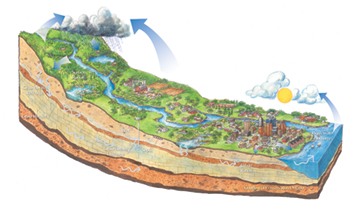Stormwater Management
The Conservation District is an expert resource for stormwater management. Our resource conservationists review stormwater plans for development projects and inspect the sites as they are built. Our watershed specialist implements projects that manage stormwater to protect local waterways, and our agricultural specialist helps manage stormwater on farms. We are available to help with stormwater concerns on your property.
Any complaints related to stormwater management should be directed to your local municipality.
What is stormwater?
When it rains, water soaks into the ground, or flows over land. In developed areas, such as Montgomery County, a large proportion of the earth’s surface is covered with impervious surfaces that rainwater can not permeate through. The water that flows over land is called “stormwater runoff”. In natural environments, there is much less stormwater runoff because vegetation absorbs and evapotranspirates rainwater, while the roots promote infiltration into the groundwater (Figure 1).
This excess of water runoff causes problems for the citizens and natural resources of Montgomery County. One danger is that the increase in water quantity causes flooding to downstream neighbors. Flooding causes water damage and increases erosion. Some property owners lose valuable streamside property to erosion each year when flooding occurs.
Figure 1 Photo credit: United States Environmental Protection Agency, Protecting Water Quality from Urban Runoff, 2003
What is Nonpoint Source Pollution?
In addition to causing destruction, stormwater picks up sediments and other pollutants that lessen the water quality of our streams and rivers. When rainwater flows over lawns, roofs, and parking lots, it picks up any pollutants from these areas, including dirt, fertilizers, oils, and other chemicals. The contaminated runoff is usually collected in storm sewers inlets, and conveyed through piping directly to our streams. Water pollution transported by stormwater is called nonpoint source pollution, because it does not come from a single point, pipe, or property.
Figure 2 Photo credit: Conservation Ontario, 2006
As the water flows downstream, the amount of pollution in the water increases. Therefore, all the nonpoint source pollution that is picked up by stormwater in Montgomery County flows through other communities, including the city of Philadelphia. Pollution such as sediments and toxic chemicals are expensive remove from dinking water supplies. It also harmful to the wildlife and fish that live in the Schuylkill and Delaware Rivers.
The Delaware Estuary is where all of our stormwater flows into the Atlantic Ocean. According to the Partnership for the Delaware Estuary, nonpoint source pollution is the biggest water quality problem for the Estuary.
What are BMPs?
Activities or structural improvements that help reduce nonpoint source pollution and limit the volume of stormwater runoff are called Best Management Practices (BMPs). BMPs are divided into two categories: structural BMPs and non-structural BMPs (Table 1). This website will help you find examples of structural BMPs in Montgomery County so you can learn how you can also help protect our water resources.
Table 1: Example of Structural and Non-Structural BMPs
| Structural BMPs | Non-Structural BMPs |
|---|---|
| Pervious pavement | Reducing impervious surfaces |
| Infiltration basins | Protecting sensitive natural resources |
| Subsurface infiltration beds | Minimizing disturbance |
| Bioinfiltration trenches | Source Control/Street sweeping |
| Rain gardens/bioretention areas | Smart growth practices |
| Dry wells and Seepage pits | Conserving riparian areas |
| Vegetated swales | Protect/utilize natural flow pathways |
| Green roof | Re-vegetate disturbed areas with native species |
| Wetponds | |
| Water quality filters on inlets | Source: PA DEP Stormwater BMP Manual |
How do BMPs reduce stormwater runoff and Nonpoint source pollution?
Non-structural BMPs limit the impact of development by good planning. Structural BMPs reduce volume and peak rates of stormwater flow, and some improve water quality. Most BMPs use vegetation to slow stormwater runoff, infiltrate the water into the soil, and absorb excess nutrients and other pollutants, cleaning the water leaving the BMP.
For more technical information on Stormwater BMPs, please refer the PA Department of Environmental Protection (DEP) Stormwater BMP Manual.

